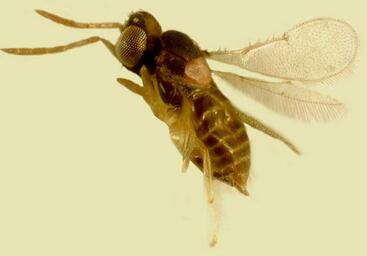Trichogrammatidae
Trichogrammatidae are parasitic on the eggs of other insects. In order to complete development their adult size can be no larger than a single insect egg, and often multiple individuals will develop in a single egg making the emerging adults but a fraction of the size of their host. Trichogrammatidae are therefore among the smallest known insects, ranging in size from 0.2 – 1.5 mm.
Certain genera such as Trichogramma are known to parasitize eggs of several insect orders, whereas other genera are apparently restricted to a single host order. The eggs of Hemiptera (true bugs, leafhoppers, etc.) are parasitized by the largest number of genera (e.g. Aphelinoidea, Paracentrobia, and Ufens), though Coleoptera (beetles) and Lepidoptera (moths and butterflies) eggs are also utilized by several genera. Most trichogrammatids parasitize eggs placed in or on plant tissues. Several genera ( e.g. Hydrophylita, Lathromeroidea and Prestwichia) parasitize eggs of aquatic insects and have been reported to swim underwater in search of hosts.
A few genera of Trichogrammatidae are of interest for use in biological control. Trichogramma has received the most attention from applied entomology because its members parasitize numerous pest Lepidoptera and can be mass propagated and released with relative ease. Trichogramma has been the world’s most widely used arthropod for augmentative biological control programs.
Recognition Trichogrammatidae are distinguished from other Chalcidoidea by their 3-segmented tarsi. Other features which help to distinguish trichogrammatids include:
- Body shape compact, less commonly elongate, but always without a distinct constriction between mesosoma (abdomen) and metasoma (thorax).
- Body light yellow to dark brown, often a combination of both, less commonly orange or red, almost never metallic.
- Cuticle smooth to moderately sculptured.
- Flagellum with 2-9 (usually 3-7) segments, including 1 or 2 anelli (rarely 3), 0-2 funicular segments, and 1-5 claval segments.
- Antenna sexually dimorphic (different between sexes) in several genera.
- Toruli at lower margin of eyes.
- Pronotum short, not obvious from above.
- Forewing varying from extremely narrow and strap-like, to very broad and only slightly rounded apically, occasionally wingless or shortwinged.
- Wing venation relatively short, usually not reaching much beyond apical half of wing.
- Postmarginal vein almost always absent (extremely short if present).
- Distribution of discal setae in both forewing and hindwing variable, but commonly arranged in distinct lines.
Diversity
The Family Trichogrammatidae currently consists of about 800 species in ca. 84 genera worldwide. The family is known from throughout the world, with representatives known from all vegetated terrestrial habitats. With the possible exception of Ittysella and Brachyufens, none of the recorded genera is restricted to the Nearctic region. Six genera, however, are recorded only from the New World (Brachista, Lathrogramma, Pintoa, Trichogrammatomyia, Xenufens, and Zagella). It is premature to speculate on relative habitat diversity. However, limited collections in the Nearctic region suggest that generic and species diversity is greater east of the Rocky Mountains and is perhaps greatest in the southeastern United States. Although the Nearctic region contains few if any endemic genera, endemicity at the species level may be considerable. Several genera such as Chaetostricha, Paracentrobia, Mirufens, and Zagella are represented by virtually undescribed faunas. To a lesser extent this problem even extends to Trichogramma, in spite of this genus’ importance to applied entomology. Likely due to their small size and soft-bodied nature and the subsequent need for specialized collecting techniques, this family has been inadequately sampled throughout the world and collections required for comprehensive taxonomic studies do not yet exist. It is clear that we currently know but a fraction of the true diversity of the Trichogrammatidae, and conservative estimates indicate that there may be more than 4000 more species remaining to be described. Consequently, most material cannot be identified to species, and in many cases cannot even be accurately ascribed to any current genus. It is likely that generic concepts will change with continued taxonomic work, with certain genera being sunk and new ones erected. The confusion still present in the Trichogrammatidae can only be alleviated with further collecting efforts and the necessary taxonomic work.
